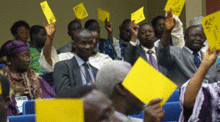25 May 2010, Silver Spring, Maryland, United States…Elizabeth Lechleitner/ANN
More than 2,400 church representatives will vote on agenda items during the Seventh-day Adventist Church’s 59th World Session this August. Who are they, and how are they selected?
The Adventist Church’s Constitution outlines the process, which began last summer. Delegates fall into one of two categories: regular delegates, those who represent various levels of church administration; and delegates at large, who represent world church entities and institutions, such as universities.
[See below story for a description of church administrative structure.]
Regular delegates — culled from administration at union conferences, union missions, conferences, missions and unions of churches — are selected either by their region’s church division headquarters, or by their respective union, the next level of church administration.
The church’s Constitution outlines specific guidelines on how many delegates each administrative body gets. Regardless of church membership size, each union conference is allotted two delegates, in addition to their president, who falls under the delegate at large category. Each union mission, which acts like a union conference but is not self-supporting, gets one delegate. Each union mission’s president is likewise considered a delegate at large.
For church administrative bodies down to the local level, the pattern continues. Both local conferences and local missions are allotted two delegates each, regardless of church membership. Unions of churches can also select two delegates, regardless of membership size.
If a union fails to fill its delegate quota, its umbrella division is at liberty to reallocate the remaining delegate slots.
The church’s 13 divisions are collectively allotted 400 additional regular delegates, to be assigned based on each division’s membership in proportion to world church membership.
When delegate quotas are based on church membership, allotment calculations factor in membership statistics as of December 31 of the second year before Session. Denominational entities eligible for sending delegates to Session must also exist as of December 31 of the same year, the church’s Constitution states.
The church’s Constitution refers to the remainder of delegates as “delegates at large.” The 20 delegates each division sends to Session fall under this category, as well as the 20 delegates selected by the church’s Executive Committee from among General Conference appointed staff.
The 300-member Executive Committee, which includes representatives from each of the church’s 13 divisions and meets biannually to conduct church business, is automatically included in the delegate tally at Session.
Also bundled into the delegates at large category are the directors and associate directors of each department and association at the church’s world headquarters in Silver Spring, Maryland.
Just as additional regular delegates are allotted based on church membership, additional delegates at large are allotted based on the number of divisional institutions in each church region.
The remainder of the delegates at large are comprised of 300 representatives of the General Conference, including employees, field secretaries, laypersons and pastors selected by the Executive Committee.
At least one-third of the total delegates must be present to form a quorum at the opening of General Conference Session in order to conduct business, the church’s Constitution states. However, in the event of a financial emergency or “other major crisis within the church or the international arena,” the Executive Committee may reduce the number of delegates needed at Session, the Constitution continues.
The Constitution also offers guidelines on delegate makeup, stating that each division’s administration is responsible for ensuring that their delegation is comprised of Adventists “in regular standing,” at least half of whom “shall be laypeople, pastors, teachers and other nonadministrative employees, of both genders, and representing a range of age groups and nationalities.”
While no specific quotas are listed, it’s “expected and assumed” that delegates represent the diversity of the church, world church undersecretary Larry Evans said.
The church’s Secretariat department is expected to release the full list of Session delegates on June 23, shortly after they are officially approved.
The Adventist Church has five levels of administration. World Church headquarters, called the General Conference, oversees 13 world church regions, or divisions. Divisions are comprised of unions, which are made up of conferences, which oversee a group of local churches. There are two types of unions and conferences: those that are financially self-sufficient and elect their own leadership, and those that depend on their respective division to handle those functions. Union conferences and conferences fall into the first category; union missions and missions into the latter. Finally, in some regions, a group of churches without a governing conference or mission will organize into what is called a union of churches, in which individual congregations report directly to their respective union.
